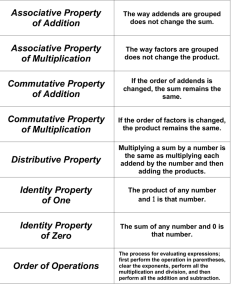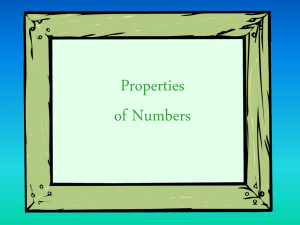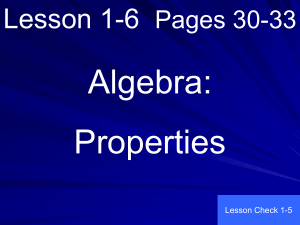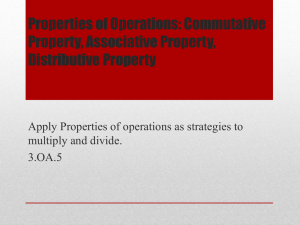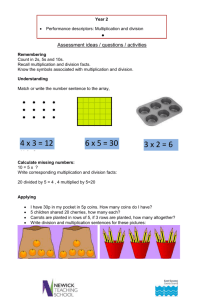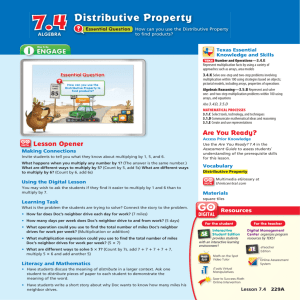3.OA_.B.5
advertisement
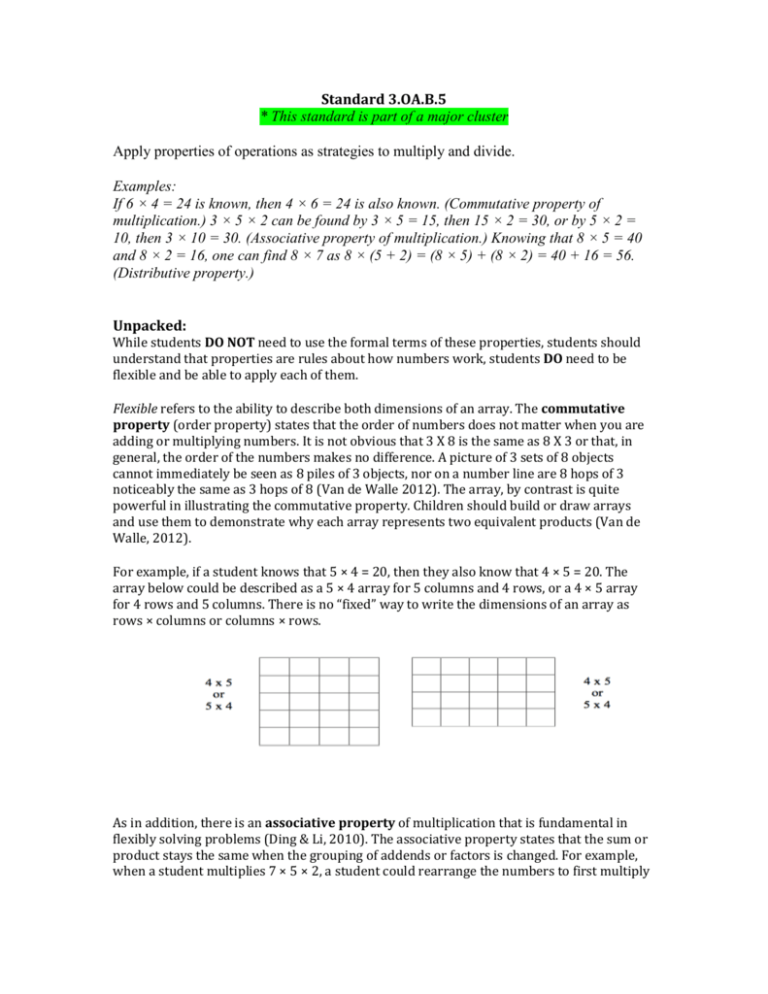
Standard 3.OA.B.5 * This standard is part of a major cluster Apply properties of operations as strategies to multiply and divide. Examples: If 6 × 4 = 24 is known, then 4 × 6 = 24 is also known. (Commutative property of multiplication.) 3 × 5 × 2 can be found by 3 × 5 = 15, then 15 × 2 = 30, or by 5 × 2 = 10, then 3 × 10 = 30. (Associative property of multiplication.) Knowing that 8 × 5 = 40 and 8 × 2 = 16, one can find 8 × 7 as 8 × (5 + 2) = (8 × 5) + (8 × 2) = 40 + 16 = 56. (Distributive property.) Unpacked: While students DO NOT need to use the formal terms of these properties, students should understand that properties are rules about how numbers work, students DO need to be flexible and be able to apply each of them. Flexible refers to the ability to describe both dimensions of an array. The commutative property (order property) states that the order of numbers does not matter when you are adding or multiplying numbers. It is not obvious that 3 X 8 is the same as 8 X 3 or that, in general, the order of the numbers makes no difference. A picture of 3 sets of 8 objects cannot immediately be seen as 8 piles of 3 objects, nor on a number line are 8 hops of 3 noticeably the same as 3 hops of 8 (Van de Walle 2012). The array, by contrast is quite powerful in illustrating the commutative property. Children should build or draw arrays and use them to demonstrate why each array represents two equivalent products (Van de Walle, 2012). For example, if a student knows that 5 × 4 = 20, then they also know that 4 × 5 = 20. The array below could be described as a 5 × 4 array for 5 columns and 4 rows, or a 4 × 5 array for 4 rows and 5 columns. There is no “fixed” way to write the dimensions of an array as rows × columns or columns × rows. As in addition, there is an associative property of multiplication that is fundamental in flexibly solving problems (Ding & Li, 2010). The associative property states that the sum or product stays the same when the grouping of addends or factors is changed. For example, when a student multiplies 7 × 5 × 2, a student could rearrange the numbers to first multiply 5 × 2 = 10 and then multiply 10 × 7 = 70. A context is helpful when learning the associative property of multiplication. Example: There are 3 bags of buttons with 5 buttons in each bag. The buttons costs $2 each. How much will it cost if we need to buy 3 bags? After students model with manipulatives or illustrate with a drawing the bags of buttons, students should consider the problem in 2 ways. 1. Find out the cost for each bag and then the total cost (2 x 5) x 3 2. Find how many buttons in total and then the cost (3 x 5) x 2 Students are introduced to the distributive property of multiplication over addition as a strategy for using products they know to solve products they don’t know. Students would be using mental math to determine a product. Here are ways that students could use the distributive property to determine the product of 7 x 6. Again, students should use the distributive property, but can refer to this in informal language such as “breaking numbers apart”. Distributive property helps students determine the products and factors of problems by breaking numbers apart. Another example of the distributive property helps students determine the products and factors of problems by breaking numbers apart. For example, for the problem 7 x 8 = ?, students can decompose the 7 into a 5 and 2, and reach the answer by multiplying 5 x 8 = 40 and 2 x 8 =16 and adding the two products (40 +16 = 56). To further develop understanding of properties related to multiplication and division, students use different representations and their understanding of the relationship between multiplication and division to determine if the following types of equations are true or false. 0x7=7x0=0 1x9=9x1=9 3x6=6x3 8÷2=2÷8 2x3x5=6x5 10 x 2 < 5 x 2 x 2 2 x 3 x 5 = 10 x 3 0x6>3x0x2 (Zero Property of Multiplication) (Multiplicative Identity Property of 1) (Commutative Property) (Students are only to determine that these are not equal) Questions to check for understanding and increase rigor: Eric says he has more donuts because his mom bought six boxes of four donuts each. Samantha says that she has more donuts because her mom bought four boxes, each with six donuts. Who is correct? Explain your thinking. Melissa needs to solve 24 x 4 in her head. What strategy should she use? Danielle is trying to multiply a strand of numbers (6 x 3 x 5) in her head but is having trouble keeping them organized in her head. Describe a strategy that she can use to solve the problem. Malcolm multiplied 3 numbers together and got 24. What 3 numbers could he have multiplied? What strategy did you use to figure the numbers out? Solve 8 x 7 using the distributive property. Could you distribute a different factor or distribute the same factor a different way?
